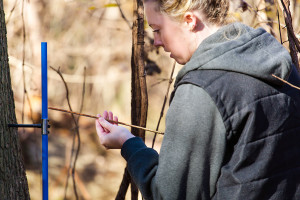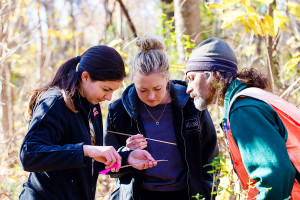What the trees are teaching us
Many of us remember looking at tree rings when we were children, counting the grooves to figure out the age of a tree. But as this year’s Urban Forestry Fellows at Rhodes College are learning, tree rings can tell us about so much more than time.

Emily Cerrito and Danielle Smith have been conducting tree coring surveys in the Old Forest State Natural Area this semester. To take their samples, Emily and Danielle use a tool called an increment borer, which they crank into the bark of a tree until reaching the center. The tool extracts a cylindrical sample of 4.3mm (about the size of the hole a yellow-bellied sapsucker drills). The students put the sample under a microscope to study it, sometimes adding dye if the wood is too light to show clear distinctions.
Occasionally a living tree is cored, but most of the work is focused on fallen trees. They’re easier to sample, particularly for large trees where the borer can’t reach the center. In a fallen tree, a slice can be cut and studied. Even the thinnest of slices can weigh about 80 pounds, so the increment borer is always used when possible. It’s tough to get an 80-pound tree cookie under a microscope!
The students can also determine the “decay class” of a fallen tree, which helps them understand the end of that tree’s life. Fallen trees’ stories continue even after they come down, of course, as they become habitat for birds and small mammals, enrich the soil, and give fungus an optimal place to grow.

The cores are compared to each other to form a more complete picture of forest dynamics. “We cored a white ash that was 114 years old when it fell,” Emily shares. “Most of the other large trees we’ve cored have been closer to 180 years old, and the younger generation is around 80 years old. So this was a different age class than we’ve been seeing, which means there was some minor regeneration happening between those two major time periods. That suggests greater diversity in the forest than we thought.”
The number of tree rings indicates age, but the size can tell some fascinating stories. Rings that are closer together (indicating slow growth) may indicate a drought period. Widely spaced rings in a tree’s early life may show that it was in an open, sunny location–possibly due to the loss of other large canopy trees–and therefore grew rapidly. If multiple trees in one part of the forest exhibit similar rings from the same time period, this might point to some interesting historical moment—a weather event, or a change in the way humans interacted with the forest.

The study of dendrochronology compares data like this to historical records. For example, the older generation of trees in the forest began growing around 1835. This time period coincides with the Indian Removal Act of 1830, which forced thousands of Choctaws out of this area. Could a significant change in the management and use of the forest have occurred around that time? We can’t know for sure, but the research may offer some clues. Understanding how the forest might have been managed in the past can offer a path toward keeping it healthy in the future.
“The purpose of our research is to figure out how the forest got where it is today, so we can figure out where it will go in the future,” says Eric Bridges, Conservancy Director of Operations. “Understanding how humans have impacted the forest over time helps us determine how we might intervene in the future.”



